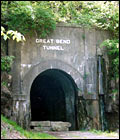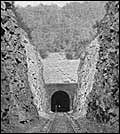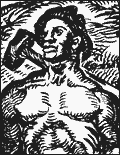John Henry in Song |
|
 |
The 11-stanza "John Henry Blues" sung by Georgia musician Fiddlin' John Carson in March 1924 marks the song's earliest appearance on a recording. Read the lyrics. |
 |
Ragtime Henry Thomas's 1927 version of "John Henry" marks the ballad's earliest African American recording with singing. Thomas, thought to be an itinerant Texas musician, accompanies himself here with guitar and panpipes. From Texas Worried Blues (Yazoo). |
 |
The Grand Ole Opry's first star, Uncle Dave
Macon, tells John Henry's story in this 1926 recording that opens with the steel driver's demise. As Macon sings "Death of John Henry" and plays the banjo, he is backed by guitarist Sam McGee. From Train 45: Railroad Songs of the Early 1900's (Rounder). |
 |
"Spike Driver Blues," Mississippi John Hurtís 1928 recording turns the work-song lyrics associated with John Henry into a loping, one-chord guitar piece that could also have served a roomful of dancers. From The Anthology of American Folk Music (Smithsonian Folkways Recordings). |
 |
John Henry
 Listen to Stephen Wade's report. Listen to Stephen Wade's report.
 Listen to early versions of the ballad of John Henry. Listen to early versions of the ballad of John Henry. Read the lyrics to "John Henry Blues," the first recording of the famous ballad. Read the lyrics to "John Henry Blues," the first recording of the famous ballad. |
Sept. 2, 2002 -- In the late 1800s, as the country recovered from the Civil War, railroad tracks began to stitch the nation together. This made it possible to go from ocean to ocean in under a week, where it might have earlier taken up to six months. Among the men that built the railroads, John Henry stands tall, broad shoulders above the rest.
Little can be said for certain about the facts of John Henry's life, but his tale has become the stuff of myth. He has embodied the spirit of growth in America for over a century.
But his legacy cannot be solely summed up in the image of a man with a hammer, a former slave representing the strength and drive of a country in the process of building itself. Something within his story established John Henry as a fixture of the popular imagination. He has been the subject of novels, a postage stamp and even animated films. Above all, "John Henry" is the single most well known and often recorded American folk song.
For NPR's ongoing series Present at the Creation, musician and researcher Stephen Wade explores John Henry's legacy and the long life of the ballad that it inspired. Wade reports that the abundance of music related to John Henry -- and more specifically, his famous contest with a steam drill -- provides a way of connecting the man himself with the citizens of the country that his work and his legend helped to build.
Though the story of John Henry sounds like the quintessential tall tale, it is certainly based, at least in part, on historical circumstance. There are disputes as to where the legend originates. Some place John Henry in West Virginia, while recent research suggests Alabama. Still, all share a similar back-story.
In order to construct the railroads, companies hired thousands of men to smooth out terrain and cut through obstacles that stood in the way of the proposed tracks. One such chore that figures heavily into some of the earliest John Henry ballads is the blasting of the Big Bend Tunnel -- more than a mile straight through a mountain in West Virginia.
Steel-drivin' men like John Henry used large hammers and stakes to pound holes into the rock, which were then filled with explosives that would blast a cavity deeper and deeper into the mountain. In the folk ballads, the central event took place under such conditions. Eager to reduce costs and speed up progress, some tunnel engineers were using steam drills to power their way into the rock. According to some accounts, on hearing of the machine, John Henry challenged the steam drill to a contest. He won, but died of exhaustion, his life cut short by his own superhuman effort.
Wade says that the song was born from the work of driving steel. "In the years before the song became known to the greater American public, it remained in folk possession," he explains. "Black songsters and white hillbilly musicians approached 'John Henry' equipped with a wealth of regional and personal styles."
Not surprisingly, the songs caught on and spread to a wider audience. Country music legend Merle Travis heard one version at an early age.
"Ever since I been big enough to remember hearing anybody sing anything at all, I believe I've heard that old song about the strong man that hammered hisself to death on the railroad," Travis said. "There's been dozens and dozens of different tales about where John Henry comes from."
The story of John Henry seems to have spoken to just about everyone who heard it, which probably accounts for why the ballad became so popular. And as the songs started to become more popular, the legend of the man grew to even larger proportions. But whatever exaggeration of deed may have ensued, an element of truth rings through.
John Cephas is a blues musician from Virginia. "It was a story that was close to being true," he says. "It's like the underdog overcoming this powerful force. I mean even into today when you hear it (it) makes you take pride. I know especially for black people, and for other people from other ethnic groups, that a lot of people are for the underdog."
Today, John Henry's legend has grown beyond the songs that helped make him famous. "Though John Henry most often appears in song," notes Wade, "he has been depicted in numerous graphic mediums ranging from folk sculpture to fine art lithography, book illustration to outdoor sculpture." This art approaches the man himself in several different ways, sometimes placing him in a historically realistic perspective and focusing on his work and life, sometimes deifying him. One 1945 illustration by James Daugherty shows John Henry as a defense worker, supported by other famous black Americans such as Joe Louis and George Washington Carver.
"Over the years," Wade continues, "labor lore scholar Archie Green has researched what he calls 'the visual John Henry.' It's from his work that these illustrations come, touching, variously, the realms of fine, popular and folk art."
Thanks to these works of art, the story of John Henry reaches a new audience that, today, may not be familiar with the songs that gave rise to the legend. Wherever people discover John Henry, his influence promises to hold strong.
In Depth
 Listen to a Aug. 4, 2001, All Things Considered interview with Colson Whitehead about his novel "John Henry Days." Read an excerpt from the book.
Listen to a Aug. 4, 2001, All Things Considered interview with Colson Whitehead about his novel "John Henry Days." Read an excerpt from the book.
 Listen to a Feb. 14, 1999, All Things Considered segment on the song "John Henry."
Listen to a Feb. 14, 1999, All Things Considered segment on the song "John Henry."
 Read about recordings from 1930s Florida folk life, including a version of the song "John Henry."
Read about recordings from 1930s Florida folk life, including a version of the song "John Henry."
 Search for more NPR reports by Stephen Wade.
Search for more NPR reports by Stephen Wade.
Other Resources
• Learn more about the legend of John Henry, The Steel Driving Man.
• Read about John Henry and the Big Bend Tunnel near Talcott, West Virginia.
• John Henry has appeared in a variety of art forms, including a "puppetoon" in 1946's John Henry and the Inky-Poo.
• Learn more about Virginia blues musician John Cephas.
A Selected Bibliography
• Long Steel Rail: The Railroad in American Folksong, by Norm Cohen. (Urbana: University of Illinois Press, 2000) pages 58-89.
• "Chasing John Henry in Alabama and Mississippi," an article by John Garst in Tributaries, Journal of the Alabama Folklife Association (No. 5, 2002) pages 92-129.
• "The Visual John Henry" in Wobblies, Pile Butts and Other Heroes, by Archie Green. (Urbana: University of Illinois Press, 1993) pages 50-74.
• John Henry: A Bio-Bibliography, by Brett Williams. (Westport: Greenwood Press, 1983).
Little can be said for certain about the facts of John Henry's life, but his tale has become the stuff of myth. He has embodied the spirit of growth in America for over a century.
But his legacy cannot be solely summed up in the image of a man with a hammer, a former slave representing the strength and drive of a country in the process of building itself. Something within his story established John Henry as a fixture of the popular imagination. He has been the subject of novels, a postage stamp and even animated films. Above all, "John Henry" is the single most well known and often recorded American folk song.
For NPR's ongoing series Present at the Creation, musician and researcher Stephen Wade explores John Henry's legacy and the long life of the ballad that it inspired. Wade reports that the abundance of music related to John Henry -- and more specifically, his famous contest with a steam drill -- provides a way of connecting the man himself with the citizens of the country that his work and his legend helped to build.
Though the story of John Henry sounds like the quintessential tall tale, it is certainly based, at least in part, on historical circumstance. There are disputes as to where the legend originates. Some place John Henry in West Virginia, while recent research suggests Alabama. Still, all share a similar back-story.
In order to construct the railroads, companies hired thousands of men to smooth out terrain and cut through obstacles that stood in the way of the proposed tracks. One such chore that figures heavily into some of the earliest John Henry ballads is the blasting of the Big Bend Tunnel -- more than a mile straight through a mountain in West Virginia.
Steel-drivin' men like John Henry used large hammers and stakes to pound holes into the rock, which were then filled with explosives that would blast a cavity deeper and deeper into the mountain. In the folk ballads, the central event took place under such conditions. Eager to reduce costs and speed up progress, some tunnel engineers were using steam drills to power their way into the rock. According to some accounts, on hearing of the machine, John Henry challenged the steam drill to a contest. He won, but died of exhaustion, his life cut short by his own superhuman effort.
Wade says that the song was born from the work of driving steel. "In the years before the song became known to the greater American public, it remained in folk possession," he explains. "Black songsters and white hillbilly musicians approached 'John Henry' equipped with a wealth of regional and personal styles."
Not surprisingly, the songs caught on and spread to a wider audience. Country music legend Merle Travis heard one version at an early age.
"Ever since I been big enough to remember hearing anybody sing anything at all, I believe I've heard that old song about the strong man that hammered hisself to death on the railroad," Travis said. "There's been dozens and dozens of different tales about where John Henry comes from."
The story of John Henry seems to have spoken to just about everyone who heard it, which probably accounts for why the ballad became so popular. And as the songs started to become more popular, the legend of the man grew to even larger proportions. But whatever exaggeration of deed may have ensued, an element of truth rings through.
John Cephas is a blues musician from Virginia. "It was a story that was close to being true," he says. "It's like the underdog overcoming this powerful force. I mean even into today when you hear it (it) makes you take pride. I know especially for black people, and for other people from other ethnic groups, that a lot of people are for the underdog."
Today, John Henry's legend has grown beyond the songs that helped make him famous. "Though John Henry most often appears in song," notes Wade, "he has been depicted in numerous graphic mediums ranging from folk sculpture to fine art lithography, book illustration to outdoor sculpture." This art approaches the man himself in several different ways, sometimes placing him in a historically realistic perspective and focusing on his work and life, sometimes deifying him. One 1945 illustration by James Daugherty shows John Henry as a defense worker, supported by other famous black Americans such as Joe Louis and George Washington Carver.
"Over the years," Wade continues, "labor lore scholar Archie Green has researched what he calls 'the visual John Henry.' It's from his work that these illustrations come, touching, variously, the realms of fine, popular and folk art."
Thanks to these works of art, the story of John Henry reaches a new audience that, today, may not be familiar with the songs that gave rise to the legend. Wherever people discover John Henry, his influence promises to hold strong.
In Depth
 Listen to a Aug. 4, 2001, All Things Considered interview with Colson Whitehead about his novel "John Henry Days." Read an excerpt from the book.
Listen to a Aug. 4, 2001, All Things Considered interview with Colson Whitehead about his novel "John Henry Days." Read an excerpt from the book.
 Listen to a Feb. 14, 1999, All Things Considered segment on the song "John Henry."
Listen to a Feb. 14, 1999, All Things Considered segment on the song "John Henry."
 Read about recordings from 1930s Florida folk life, including a version of the song "John Henry."
Read about recordings from 1930s Florida folk life, including a version of the song "John Henry." Search for more NPR reports by Stephen Wade.
Search for more NPR reports by Stephen Wade.
Other Resources
• Learn more about the legend of John Henry, The Steel Driving Man.
• Read about John Henry and the Big Bend Tunnel near Talcott, West Virginia.
• John Henry has appeared in a variety of art forms, including a "puppetoon" in 1946's John Henry and the Inky-Poo.
• Learn more about Virginia blues musician John Cephas.
A Selected Bibliography
• Long Steel Rail: The Railroad in American Folksong, by Norm Cohen. (Urbana: University of Illinois Press, 2000) pages 58-89.
• "Chasing John Henry in Alabama and Mississippi," an article by John Garst in Tributaries, Journal of the Alabama Folklife Association (No. 5, 2002) pages 92-129.
• "The Visual John Henry" in Wobblies, Pile Butts and Other Heroes, by Archie Green. (Urbana: University of Illinois Press, 1993) pages 50-74.
• John Henry: A Bio-Bibliography, by Brett Williams. (Westport: Greenwood Press, 1983).


In 1972, Michigan sculptor Charles Cooper completed this eight-foot bronze statue of John Henry. It stands in Memorial Park above the east portal of the Big Bend Tunnel near Talcott, West Virginia.
Photo: Carla Leslie, Summers County Convention & Visitors Bureau
View enlargement.

Most accounts have set the ballad of John Henry at the Big Bend Tunnel, near Talcott in Summers County. Originally called the Great Bend Tunnel, it was built between 1870-72 for the C & O Railroad.
Photo: Carla Leslie, Summers County Convention & Visitors Bureau
View enlargement.

The Coosa Tunnel -- one of two railroad tunnels built in 1887-88 for the Columbus & Western Railroad near Leeds, Ala., may have been the site of the events in the ballad.
Photo: Fruits of Industry: Points and Pictures along the Central Railroad of Georgia by A. Pleasant Stovall and O. Pierre Havens, 1895.
View enlargement.

"John Henry Building a Railroad." From a series of woodcuts about the song that Manhattan engraver and printmaker Fred Becker created for the WPA Federal Art Project in 1936.
Photo courtesy Keith Sheridan Inc.
View enlargement.

In 1945, Indiana-born illustrator James Daugherty drew John Henry as a defense worker.
Photo: JEMF Quarterly
View enlargement.

Former C & O railroad worker, fiddler and self-taught artist Shields Landon Jones carved this figure of John Henry pictured at the 1972 West Virginia state fair where it took first prize.
Photo: JEMF Quarterly
View enlargement.